sensor KIA Opirus 2007 1.G Owner's Manual
[x] Cancel search | Manufacturer: KIA, Model Year: 2007, Model line: Opirus, Model: KIA Opirus 2007 1.GPages: 283, PDF Size: 18.42 MB
Page 40 of 283
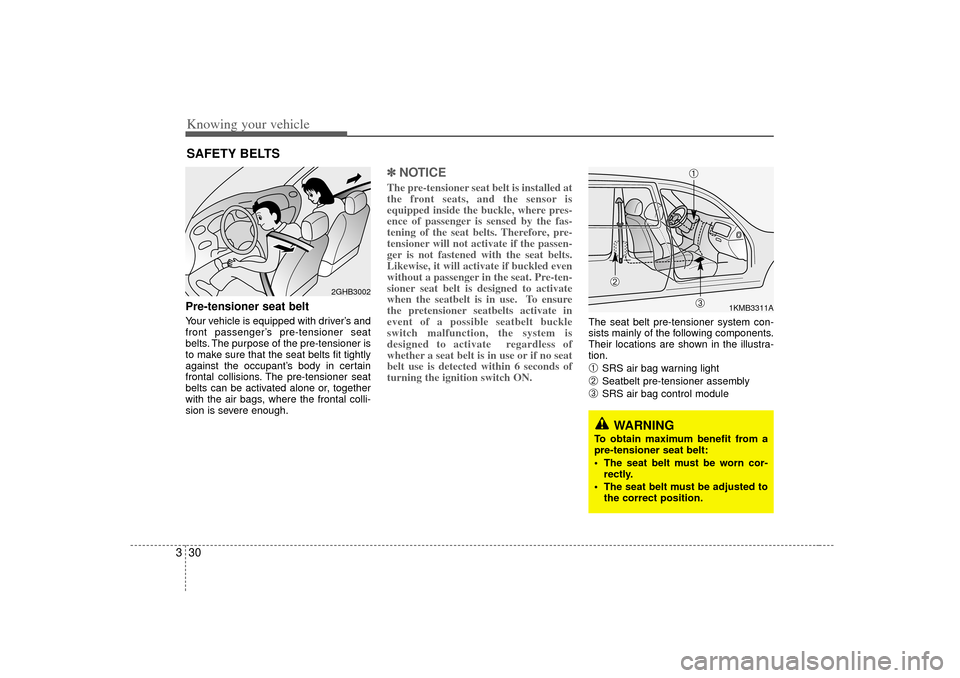
Knowing your vehicle30
3Pre-tensioner seat beltYour vehicle is equipped with driver’ s and
front passenger’ s pre-tensioner seat
belts. The purpose of the pre-tensioner is
to make sure that the seat belts fit tightly
against the occupant’ s body in certain
frontal collisions. The pre-tensioner seat
belts can be activated alone or, together
with the air bags, where the frontal colli-
sion is severe enough.
✽ ✽ NOTICEThe pre-tensioner seat belt is installed at
the front seats, and the sensor is
equipped inside the buckle, where pres-
ence of passenger is sensed by the fas-
tening of the seat belts. Therefore, pre-
tensioner will not activate if the passen-
ger is not fastened with the seat belts.
Likewise, it will activate if buckled even
without a passenger in the seat. Pre-ten-
sioner seat belt is designed to activate
when the seatbelt is in use. To ensure
the pretensioner seatbelts activate in
event of a possible seatbelt buckle
switch malfunction, the system is
designed to activate regardless of
whether a seat belt is in use or if no seat
belt use is detected within 6 seconds of
turning the ignition switch ON.
The seat belt pre-tensioner system con-
sists mainly of the following components.
Their locations are shown in the illustra-
tion.➀
SRS air bag warning light
➁
Seatbelt pre-tensioner assembly
➂
SRS air bag control module
SAFETY BELTS
2GHB3002
WARNING
To obtain maximum benefit from a
pre-tensioner seat belt:
The seat belt must be worn cor-
rectly.
The seat belt must be adjusted to the correct position.
1KMB3311A
➀
➁
➂
Page 41 of 283
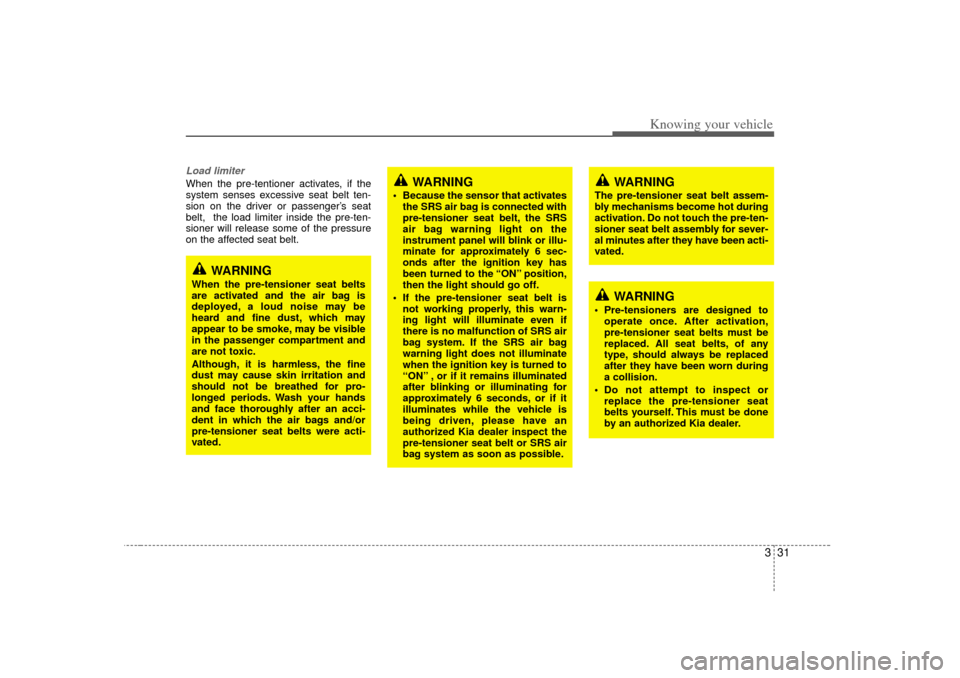
331
Knowing your vehicle
Load limiter When the pre-tentioner activates, if the
system senses excessive seat belt ten-
sion on the driver or passenger’s seat
belt, the load limiter inside the pre-ten-
sioner will release some of the pressure
on the affected seat belt.
WARNING
When the pre-tensioner seat belts
are activated and the air bag is
deployed, a loud noise may be
heard and fine dust, which may
appear to be smoke, may be visible
in the passenger compartment and
are not toxic.
Although, it is harmless, the fine
dust may cause skin irritation and
should not be breathed for pro-
longed periods. Wash your hands
and face thoroughly after an acci-
dent in which the air bags and/or
pre-tensioner seat belts were acti-
vated.
WARNING
Because the sensor that activates the SRS air bag is connected with
pre-tensioner seat belt, the SRS
air bag warning light on the
instrument panel will blink or illu-
minate for approximately 6 sec-
onds after the ignition key has
been turned to the “ON” position,
then the light should go off.
If the pre-tensioner seat belt is not working properly, this warn-
ing light will illuminate even if
there is no malfunction of SRS air
bag system. If the SRS air bag
warning light does not illuminate
when the ignition key is turned to
“ON” , or if it remains illuminated
after blinking or illuminating for
approximately 6 seconds, or if it
illuminates while the vehicle is
being driven, please have an
authorized Kia dealer inspect the
pre-tensioner seat belt or SRS air
bag system as soon as possible.
WARNING
Pre-tensioners are designed tooperate once. After activation,
pre-tensioner seat belts must be
replaced. All seat belts, of any
type, should always be replaced
after they have been worn during
a collision.
Do not attempt to inspect or replace the pre-tensioner seat
belts yourself. This must be done
by an authorized Kia dealer.
WARNING
The pre-tensioner seat belt assem-
bly mechanisms become hot during
activation. Do not touch the pre-ten-
sioner seat belt assembly for sever-
al minutes after they have been acti-
vated.
Page 62 of 283
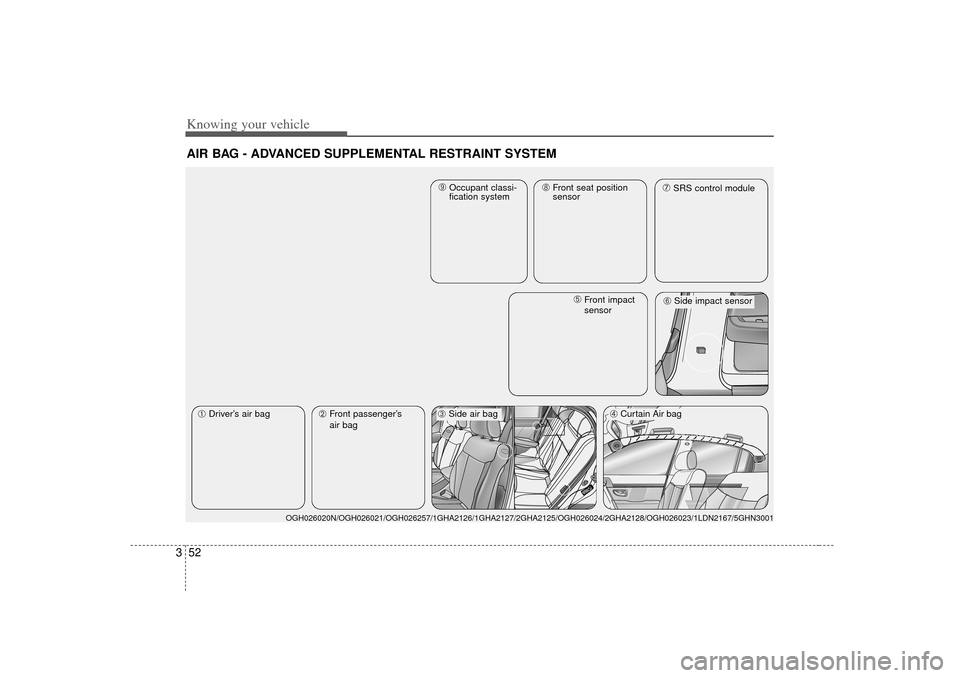
Knowing your vehicle52
3AIR BAG - ADVANCED SUPPLEMENTAL RESTRAINT SYSTEM ➀Driver’ s air bag
➁Front passenger’ s
air bag
➃Curtain Air bag
➄Front impact
sensor
➆SRS control module\bSide impact sensor
OGH026020N/OGH026021/OGH026257/1GHA2126/1GHA2127/2GHA2125/OGH026024/2GHA\
2128/OGH026023/1LDN2167/5GHN3001
➂Side air bag\fOccupant classi-
fication system
➇Front seat position
sensor
Page 65 of 283
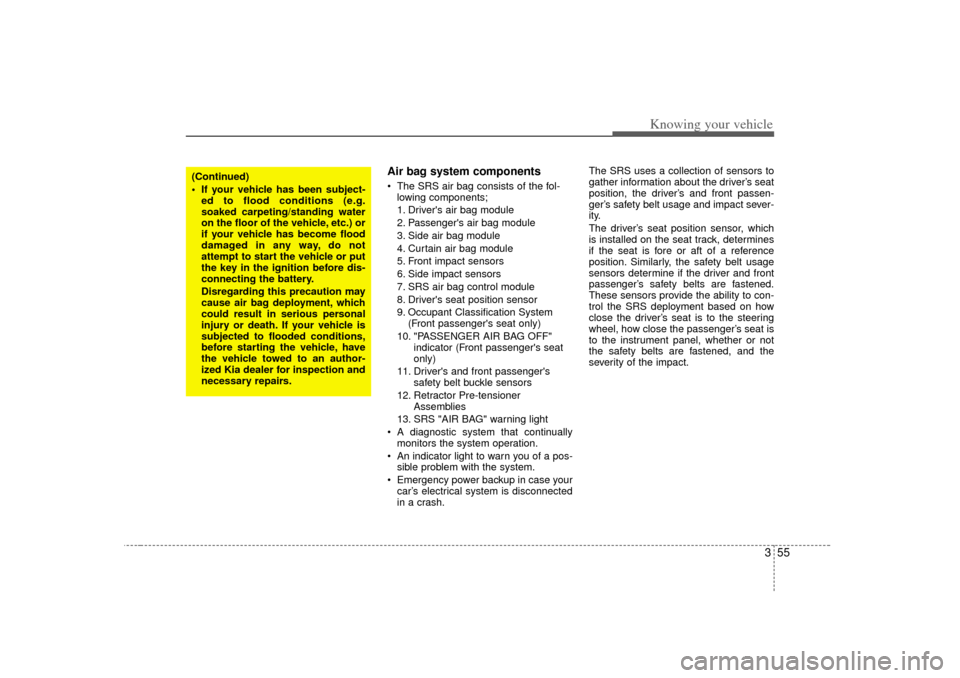
355
Knowing your vehicle
Air bag system components The SRS air bag consists of the fol-
lowing components;
1. Driver's air bag module
2. Passenger's air bag module
3. Side air bag module
4. Curtain air bag module
5. Front impact sensors
6. Side impact sensors
7. SRS air bag control module
8. Driver's seat position sensor
9. Occupant Classification System
(Front passenger's seat only)
10. "PASSENGER AIR BAG OFF" indicator (Front passenger's seat
only)
11. Driver's and front passenger's safety belt buckle sensors
12. Retractor Pre-tensioner Assemblies
13. SRS "AIR BAG" warning light
A diagnostic system that continually
monitors the system operation.
An indicator light to warn you of a pos-
sible problem with the system.
Emergency power backup in case your
car’ s electrical system is disconnected
in a crash. The SRS uses a collection of sensors to
gather information about the driver
’s seat
position, the driver’ s and front passen-
ger’ s safety belt usage and impact sever-
ity.
The driver’ s seat position sensor, which
is installed on the seat track, determines
if the seat is fore or aft of a reference
position. Similarly, the safety belt usage
sensors determine if the driver and front
passenger’ s safety belts are fastened.
These sensors provide the ability to con-
trol the SRS deployment based on how
close the driver’ s seat is to the steering
wheel, how close the passenger’ s seat is
to the instrument panel, whether or not
the safety belts are fastened, and the
severity of the impact.
(Continued)
If your vehicle has been subject- ed to flood conditions (e.g.
soaked carpeting/standing water
on the floor of the vehicle, etc.) or
if your vehicle has become flood
damaged in any way, do not
attempt to start the vehicle or put
the key in the ignition before dis-
connecting the battery.
Disregarding this precaution may
cause air bag deployment, which
could result in serious personal
injury or death. If your vehicle is
subjected to flooded conditions,
before starting the vehicle, have
the vehicle towed to an author-
ized Kia dealer for inspection and
necessary repairs.
Page 66 of 283
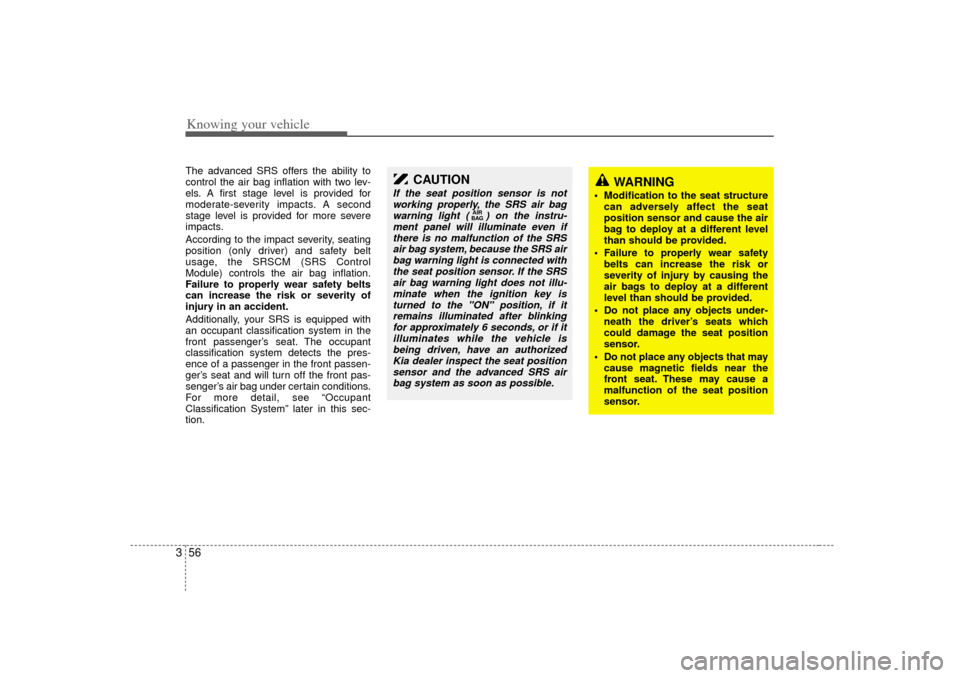
Knowing your vehicle56
3The advanced SRS offers the ability to
control the air bag inflation with two lev-
els. A first stage level is provided for
moderate-severity impacts. A second
stage level is provided for more severe
impacts.
According to the impact severity, seating
position (only driver) and safety belt
usage, the SRSCM (SRS Control
Module) controls the air bag inflation.
Failure to properly wear safety belts
can increase the risk or severity of
injury in an accident.
Additionally, your SRS is equipped with
an occupant classification system in the
front passenger’ s seat. The occupant
classification system detects the pres-
ence of a passenger in the front passen-
ger’ s seat and will turn off the front pas-
senger’ s air bag under certain conditions.
For more detail, see “Occupant
Classification System” later in this sec-
tion.
CAUTION
If the seat position sensor is not working properly, the SRS air bag warning light ( ) on the instru-ment panel will illuminate even ifthere is no malfunction of the SRS air bag system, because the SRS airbag warning light is connected with the seat position sensor. If the SRSair bag warning light does not illu- minate when the ignition key isturned to the "ON" position, if it remains illuminated after blinkingfor approximately 6 seconds, or if it illuminates while the vehicle isbeing driven, have an authorizedKia dealer inspect the seat positionsensor and the advanced SRS air bag system as soon as possible.
AIR
BAG
WARNING
Modification to the seat structure
can adversely affect the seat
position sensor and cause the air
bag to deploy at a different level
than should be provided.
Failure to properly wear safety belts can increase the risk or
severity of injury by causing the
air bags to deploy at a different
level than should be provided.
Do not place any objects under- neath the driver’s seats which
could damage the seat position
sensor.
Do not place any objects that may cause magnetic fields near the
front seat. These may cause a
malfunction of the seat position
sensor.
Page 73 of 283
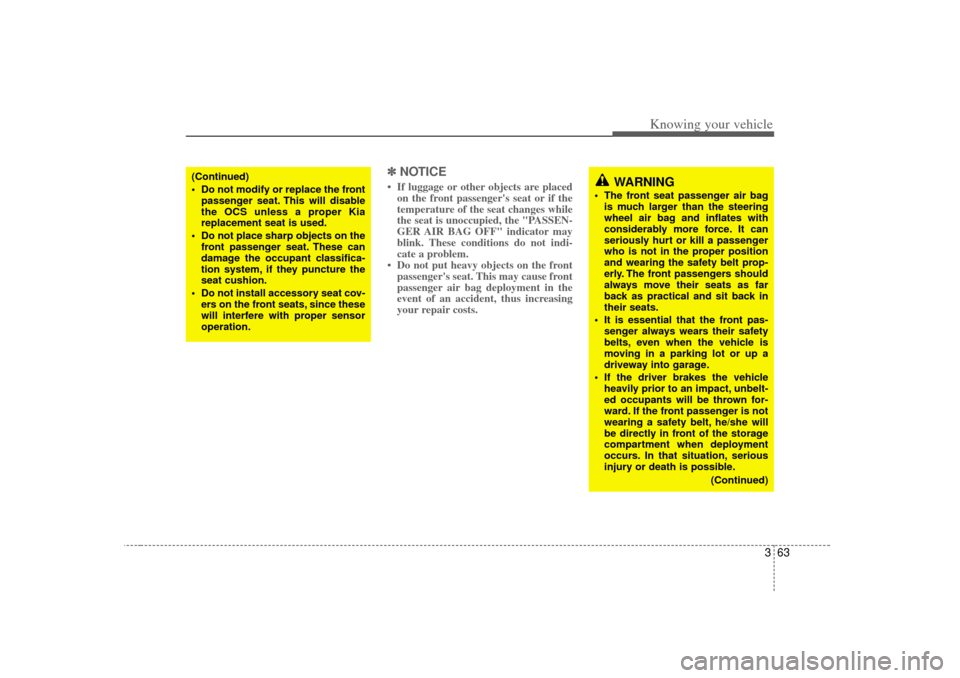
363
Knowing your vehicle
✽
✽NOTICE• If luggage or other objects are placed
on the front passenger's seat or if the
temperature of the seat changes while
the seat is unoccupied, the "PASSEN-
GER AIR BAG OFF" indicator may
blink. These conditions do not indi-
cate a problem.
• Do not put heavy objects on the front passenger's seat. This may cause front
passenger air bag deployment in the
event of an accident, thus increasing
your repair costs.
WARNING
The front seat passenger air bag
is much larger than the steering
wheel air bag and inflates with
considerably more force. It can
seriously hurt or kill a passenger
who is not in the proper position
and wearing the safety belt prop-
erly. The front passengers should
always move their seats as far
back as practical and sit back in
their seats.
It is essential that the front pas- senger always wears their safety
belts, even when the vehicle is
moving in a parking lot or up a
driveway into garage.
If the driver brakes the vehicle heavily prior to an impact, unbelt-
ed occupants will be thrown for-
ward. If the front passenger is not
wearing a safety belt, he/she will
be directly in front of the storage
compartment when deployment
occurs. In that situation, serious
injury or death is possible.
(Continued)
(Continued)
Do not modify or replace the frontpassenger seat. This will disable
the OCS unless a proper Kia
replacement seat is used.
Do not place sharp objects on the front passenger seat. These can
damage the occupant classifica-
tion system, if they puncture the
seat cushion.
Do not install accessory seat cov- ers on the front seats, since these
will interfere with proper sensor
operation.
Page 76 of 283
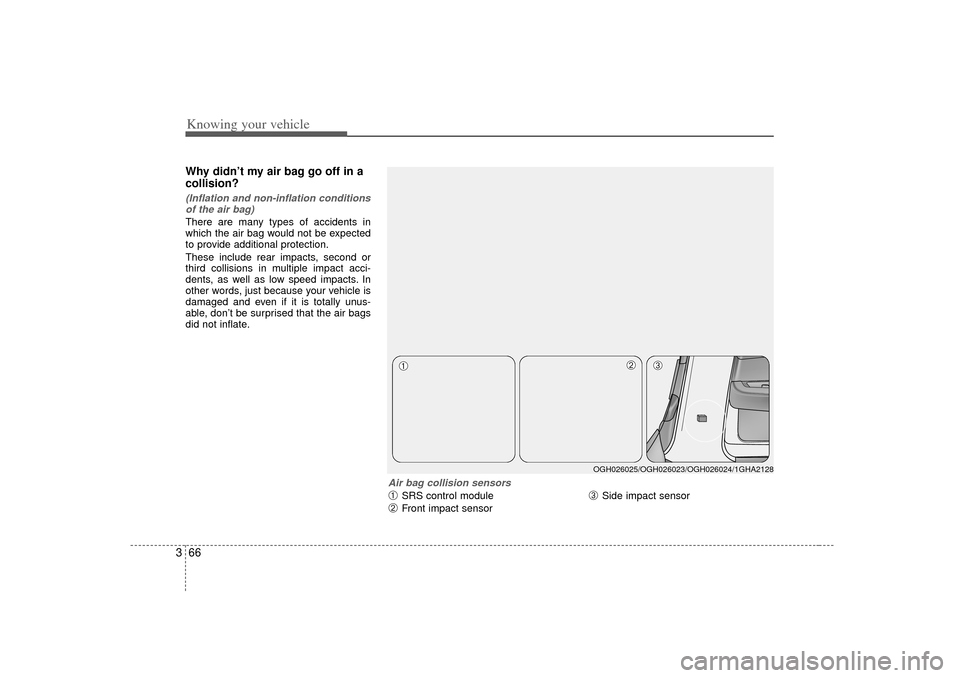
Knowing your vehicle66
3Why didn’t my air bag go off in a
collision? (Inflation and non-inflation conditions
of the air bag)There are many types of accidents in
which the air bag would not be expected
to provide additional protection.
These include rear impacts, second or
third collisions in multiple impact acci-
dents, as well as low speed impacts. In
other words, just because your vehicle is
damaged and even if it is totally unus-
able, don’t be surprised that the air bags
did not inflate.
Air bag collision sensors➀
SRS control module
➁
Front impact sensor
➂
Side impact sensorOGH026025/OGH026023/OGH026024/1GHA2128
➀
➁
➂
Page 77 of 283
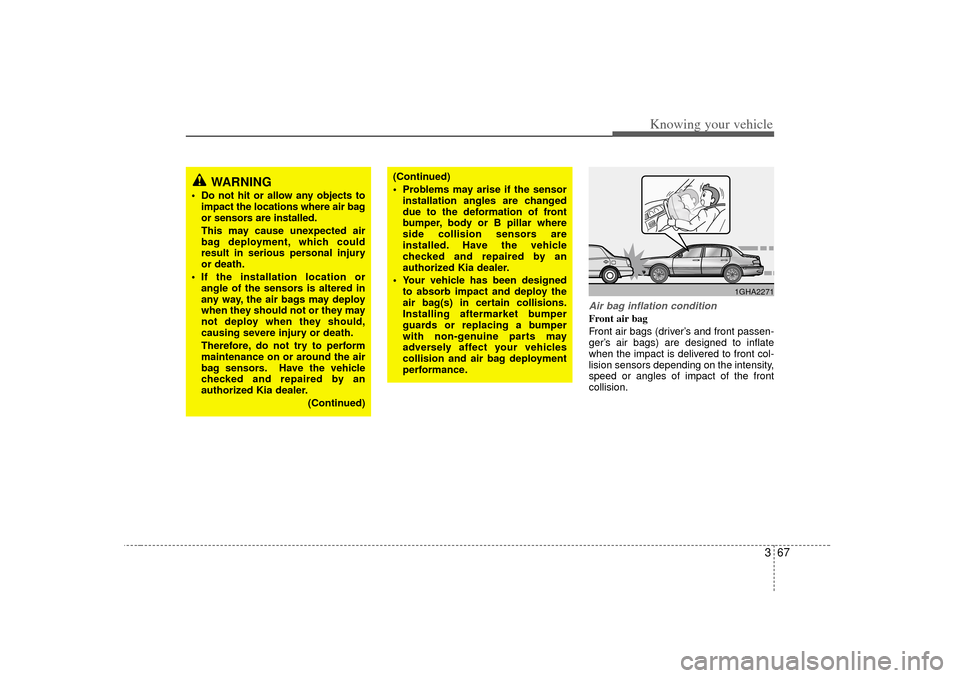
367
Knowing your vehicle
Air bag inflation conditionFront air bag
Front air bags (driver’s and front passen-
ger’ s air bags) are designed to inflate
when the impact is delivered to front col-
lision sensors depending on the intensity,
speed or angles of impact of the front
collision.
WARNING
Do not hit or allow any objects to impact the locations where air bag
or sensors are installed.
This may cause unexpected air
bag deployment, which could
result in serious personal injury
or death.
If the installation location or angle of the sensors is altered in
any way, the air bags may deploy
when they should not or they may
not deploy when they should,
causing severe injury or death.
Therefore, do not try to perform
maintenance on or around the air
bag sensors. Have the vehicle
checked and repaired by an
authorized Kia dealer.
(Continued)
(Continued)
Problems may arise if the sensorinstallation angles are changed
due to the deformation of front
bumper, body or B pillar where
side collision sensors are
installed. Have the vehicle
checked and repaired by an
authorized Kia dealer.
Your vehicle has been designed to absorb impact and deploy the
air bag(s) in certain collisions.
Installing aftermarket bumper
guards or replacing a bumper
with non-genuine parts may
adversely affect your vehicles
collision and air bag deployment
performance.
1GHA2271
Page 78 of 283
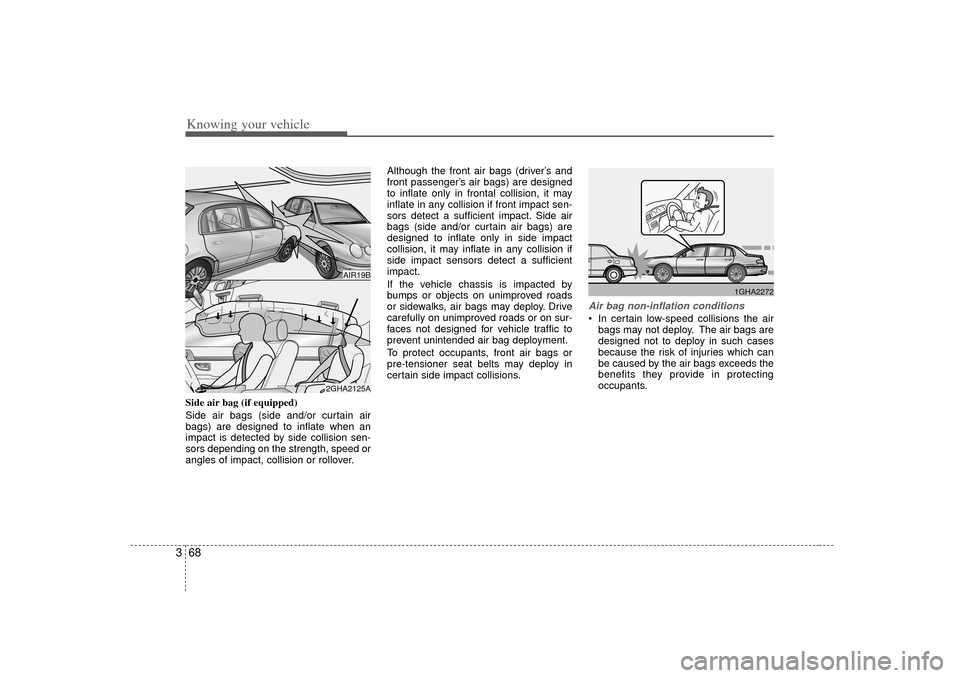
Knowing your vehicle68
3Side air bag (if equipped)
Side air bags (side and/or curtain air
bags) are designed to inflate when an
impact is detected by side collision sen-
sors depending on the strength, speed or
angles of impact, collision or rollover. Although the front air bags (driver
’s and
front passenger’ s air bags) are designed
to inflate only in frontal collision, it may
inflate in any collision if front impact sen-
sors detect a sufficient impact. Side air
bags (side and/or curtain air bags) are
designed to inflate only in side impact
collision, it may inflate in any collision if
side impact sensors detect a sufficient
impact.
If the vehicle chassis is impacted by
bumps or objects on unimproved roads
or sidewalks, air bags may deploy. Drive
carefully on unimproved roads or on sur-
faces not designed for vehicle traffic to
prevent unintended air bag deployment.
To protect occupants, front air bags or
pre-tensioner seat belts may deploy in
certain side impact collisions.
Air bag non-inflation conditions In certain low-speed collisions the air
bags may not deploy. The air bags are
designed not to deploy in such cases
because the risk of injuries which can
be caused by the air bags exceeds the
benefits they provide in protecting
occupants.
AIR19B
2GHA2125A
1GHA2272
Page 79 of 283
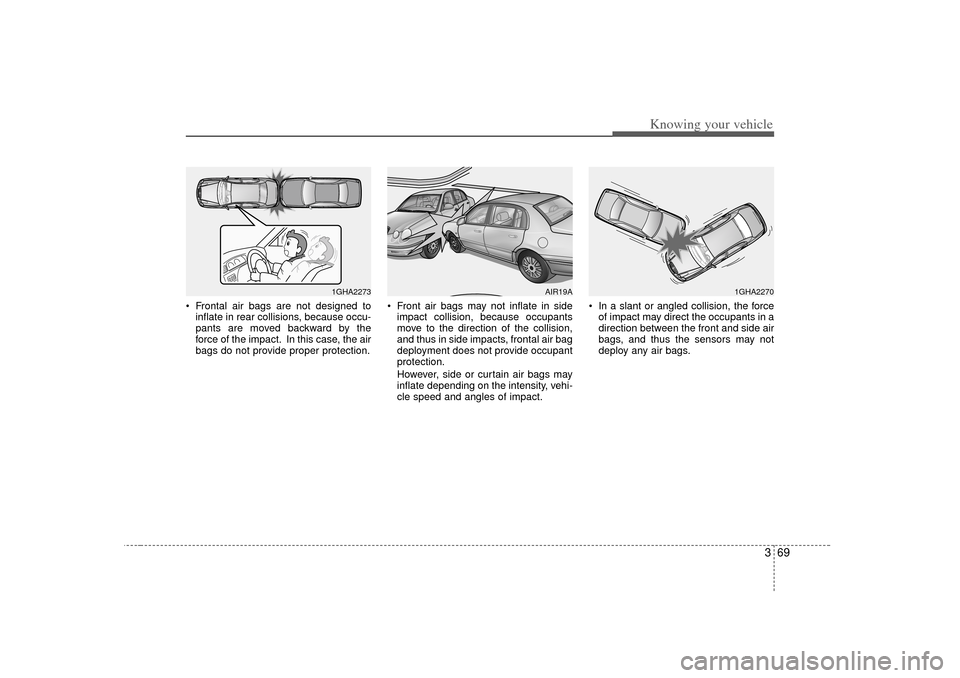
369
Knowing your vehicle
Frontal air bags are not designed to
inflate in rear collisions, because occu-
pants are moved backward by the
force of the impact. In this case, the air
bags do not provide proper protection.
Front air bags may not inflate in side
impact collision, because occupants
move to the direction of the collision,
and thus in side impacts, frontal air bag
deployment does not provide occupant
protection.
However, side or curtain air bags may
inflate depending on the intensity, vehi-
cle speed and angles of impact.
In a slant or angled collision, the force
of impact may direct the occupants in a
direction between the front and side air
bags, and thus the sensors may not
deploy any air bags.
1GHA2273
AIR19A
1GHA2270